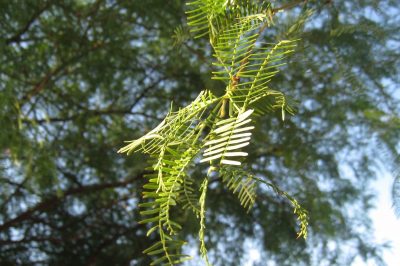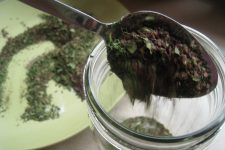This time of year, if you live anywhere in the Southwestern part of the US from Southern Kansas down through Texas and over to Southern California, you may begin to notice your local mesquite trees heavy laden with fruit that strongly resembles a bean pod or some type of legume.
Not only are these mesquite pods edible, but their deliciously sweet, nutty flavor is a wonderful addition to all sorts of baked goods, smoothies, milks, raw food meals, and gravies. Additionally they are highly nutritious, containing significant amounts of protein, fiber, and minerals — not to mention mesquite flour is gluten-free!
The pods are usually ready to harvest mid-July through September, however earlier this week we had some very high winds in the desert near my home which knocked many of the pods to the ground.
I couldn’t just leave them lying there…the creative forager in me was ignited!
Note: It’s best to harvest from the tree, not the ground, due to potential infestation of the pod by insects. But I felt comfortable harvesting the pods because I knew they had only been there a day or two. And as always when foraging wild edibles be sure to leave plenty for the birds and wildlife, we share it with them too 🙂
History of the Mesquite
Indigenous peoples to this region of the country used the mesquite tree for everything, not only as a food source! From soothing the digestive system to use as an anti-fungal and antibiotic to making bows, arrows, and sewing needles with the wood from the tree…the mesquite was a primary means for survival.
Historically the dried pods and seeds were milled (ground into flour) using a stone. This was done prior to mixing with water and forming it into a cake for consumption.
One of the greatest benefits of foraging, in my opinion, is the reconnection made to the land and it’s history — and to reviving tradition.
Making Mesquite Flour ~ A Picture Tutorial
Gather the Supplies
-Mesquite pods
-A tool for grinding
- Vitamix blender
- Standard blender
- Cheap electric coffee grinder
-Spoon
–Fine mesh sieve or sifter
-Glass jar for storage
Method

1. The mesquite pods should be completely dehydrated prior to grinding into flour. Mine were still a bit “green” so I set them in the solar oven for a few hours until they were dried and light tan in color. Note: This can also be done in an oven or dehydrator set to a low setting of 110 or 150 degrees Fahrenheit. The sun is also a brilliant option.

2. Break the pods into small 1-2 inch pieces and place them into a blender (I use my vitamix for this and lots of other raw food processing). Note: You can also use a cheapo coffee grinder. Just be sure that it’s one used only for this purpose and not coffee…otherwise your flour will end up tasting like coffee!

3. This grinding will produce a flour that quite “chunky” and still contains pieces of whole pod and seed.

4. Therefore, sifting is necessary to extract the fine flour. Continue to re-blend the pod and seed pieces until all is milled into powder form. Note: Feel free to compost (or use them to make mesquite milk) those pieces that just won’t grind up. I always have some that resist 🙂

5. You should begin to smell the lovely sweet, nutty scent of the mesquite! At this point I recommend that you taste it…ideas about how you can add this power flour to your cooking and baking life are sure to fill the creative spaces of your mind. Be aware, as with most gluten-free flours, a little bit of mesquite goes a long way. Note: I like to start with substituting 1 tablespoon of mesquite flour per 1 cup of regular flour in a variety of recipes. Adding a tablespoon to your green smoothie is also an excellent way to incorporate it into your diet. Beyond that…this has many wonderful uses for the raw foodie.

6. Keep stored in a glass jar. A cool, dark place is ideal. The flour should stay fresh for up to 6 months.
Learn More
Has this post peaked your interest in learning more about the benefits of mesquite? Check out these sites:
- Desert Harvesters
- Click here for TONS of great recipes using mesquite pod flour. Including a recipe for Vanilla Hemp Mesquite Milk…yummo!
- More Recipes
- Mesquite pods — when roasted — make a wonderful beverage commonly known as “mesquite coffee.”
Not in an area where mesquite trees grow freely? There are a few companies that sell mesquite flour online, like this one. I’ve never had to buy it, obviously (smile) — so I can’t really speak to the quality — but it may be worth a try!?!
Tell us, what wild edibles are you harvesting, or looking forward to harvesting, these days?





Ive heard of this on the VPA (valley permaculture alliance) website. They did a pancake breakfast thing after the harvest! I wish I had a mesquite tree …. Do they come in bush form? I have these bushes with pods and I can’t figure out what they are!
If you live in the Valley, Sarah, the mesquite trees are all over! You can harvest beans from parks and washes, that’s where I get mine! Not sure about your bush though, what do the pods look like?
Hi,
Thank you so much for this fascinating explanation about mesquite flour. I have a Mexican cacahuete, (mortar and pestle) , that works beautifully. I was not sure whether I could grind up the whole pod for consumption, but your explanation was very clear. I live in the high desert above Palm Springs, CA and there are any number of trees giving up pods in the late summer. I was collecting them for their seeds, but now, thanks to you, I will be baking bread with my own mesquite flour!
On the land where I live there a lot of wild buckwheat plants. If the rains provide us with enough of a harvest I shall be giving them a go, as well. Thanks again,
Sampatti
Those small bushes with pods are cassia bushes. They have small yellow flowers. Those would not work for flour. I am going to make flour today for the first time. I have a lot of Mesquite Trees on my Property. If you want to join me sometime let me know. I will be doing Olive Harvest in October too.
Mesquite flour is something we enjoy very much. We use a couple of tablespoon fulls in our GF sourdough waffles on weekends. I have only bought the flour, but we are now leasing 20 acres with numerous mesquites, so I will be using your tutorial to make flour and perhaps try making some mesquite molasses out of the leftover pieces of pods. Thanks so much!!
this is a new idea for me, and since I live in Texas, there is plenty of mesquite to be had! Heading out to go forage now!!!!
We absolutely love all your content here. Thanks for all the great information!
In case you are interested,
http://ourearthland.blogspot.ca/2012/06/versatile-blogger-award.html
This is fantastic.
not only do I know people with celiacs, but I know people who live around a bunch of mesquite trees….
unfortunately I live in washington, so none to be had around here. I will make my mother in law try this!
Cheers, candice
I’ve been wanting to know how to make mesquite flour! We have two trees and I I swear nearly every neighbor on the block does too. What do you use your flour in? Hello from Goodyear BTW!!
Awesome Stephanie! I use it in pancakes, all types of breads (banana and zucchini namely), I make mesquite milk with it, we love a tablespoon in smoothies. Check out those links to the recipes…they will give you SO many great ideas!
Did grinding the pods have any effect on your vitamix? I just did this with my blendtec and it appears to have pitted my blendtec container. 🙁
My worries as well. My food processor is stronger than my Ninja blender, but it started to smell like it was burning.
What is the best way to grind those pics.
Is there a certain time that they need picked, like green, or can they be there finishing red?
Love this, I can’t wait to try, thanks for sharing!! 🙂
It’s perfect time to make some plans for the future and it’s time to be
happy. I have read this post and if I could I desire to suggest
you some interesting things or tips. Perhaps you could write
next articles referring to this article. I want to read even more things about it!
I sell mesquite pod flour on my site if anyone needs some! Or call (916) 803-7624. Thanks!
My site is Etsy.com/shops/missrochelle
I have read that mesquite beans will not grind in a grain grinder. There is a group that takes around a special grinder here in Tucson for grinding mesquite beans. I have never caught up with them. I worry about ruinnning the blades on my vitamix. Do you use the grain griding container? I have just boiled the entire pod and then strained out the seed, etc to get a really good soup. Thanks, Cheryl
I was able to grind it into flour using the Nutribullet with the milling attachment . I had to sift it and remix it several times, but I did get a flour. Unfortunately, I damaged my small cup and the base of the grinding tool. Since both are made of plastic, the seeds made small pock marks over the base of the mill attachment and the rim of the cup. 🙁 I would be careful if you are using your vitamix since that is made of plastic as well. Anyone else have a similar experience?
Great article! I discovered, by chance, that the bugs infest the pods on the tree also. Good thing I had the pods in a ziplock bag. They were crawling all over 🙂
I harvested my mesquite pods from my trees, checked each and everyone of them for any signs of infestation and removed those showing signs. Placed my pods inside a clean paper box and brought indoors. Had visitors for a few days. When preparing to mill my mesquite flour I opened the box to find it contained a good amount of some flying beetles who were really enjoying my mesquite pods. Should I be washing these pods and redrying them to prevent this from happening again. Or should I just enjoy the extra source of protein??? Obviously what occurred is the insects had laid eggs on the exterior of the pods unseen by the naked eye.
The pods are safe once the beetle have hatched from them. Use only pods that have little holes in them, the beetles have hatched from these pods and discard any pod that does not have little burr holes in them as the beetles are still inside of those pods. Once you have selected the pods that the beetles have hatched from, fill your kitchen sink with water and put about a teaspon of bleach in the water. (Do not use more bleach it should be extremely dilute). Swish the beans around in the water for about 5 minutes and then drain the water. Remove excess water and then place the beans in a dehydrator overnight. Once you have done this you can then grind them in a blender, grinder etc. It is a very fine powder I do mine outside or it gets everywhere. Sift in a big collander and then discard the hard centers of the bean that do not grind up. Then grind the sifted portion until very fine and your flour is done. The Boyce Thompson Aboretum in Superior Arizona offers classes periodically on this along with many other useful classes.
You can process Screw Bean Mesquite Pods in the same way. They have tiny little seeds in them and I find them little easier to process than regular mesquite pods with the bigger seeds. I put them in the freezer first. This helps end the little insect cycle they have. You can wash them before putting them into the freezer. (Emily’s comment for washing is an option) Let them dry before freezing. Screw Bean Mesquite Trees have a lot of thorns. I find it best to collect the pods off the ground after a wind storm. They are not as green once they fall to the ground. You want the more yellow looking pods. The golden to brown colored pods have been sitting there too long. Once I have collected a five pounds or more, I take them out of the freezer and pull the little arms off the stems, spread them on cookie sheets and bake them at 300F for about 20 minutes. Let them cool. (They are in the Bean/Pea family) Proceed with processing them down into smaller pieces with a blender. I run them thru my Whisper/Wonder grain mill next. (They have grind up well in my mill, but the regular pods do not.) If you do not have grain mill, processing them down with a blender first, then use a coffee mill to produce a finer flour. Sift as you go. Screw Bean Mesquite Flour is as wonderful as Honey or Velvet Mesquite Flour and just as sweet. I find it grinds up finer than regular mesquite pods.
I hate to sound all capitalistic, but mesquite milk sounds like a business opportunity.
I’d be a customer.
Every year my dogs eat the mesquite pods as they fall from the tree. They love them, they chew on them as if they were dog treats, & they get fat every year during this time.. You must be careful that you or your pets do not eat pods that are moldy, as this can be deadly. Only pick from trees or newly dropped on the ground. If it looks old, pass it by. We had two crops of mesquite beans this year in Tucson. Tomorrow I am going to go out and gather all the good ones, so I can try to make this flour. Thank you so much, I’m dying to try this.
Can you harvest any of the mesquite beans? Are they all edible?
Andrea,
Thank you for an excellent article. Clear, comcise and spot-on. As an old time avid mesquite harvister i have to applaud you. One point of encouragement: The mesquite is known as the tree of life, as no part of it is unuseful. Composting the “chaff” is one use but you are still wasting a rich source of protein and healthful biproduct. Steep a cup in a gallon of water, then add stevia, honey or VT maple syrup to taste. This tea has anti-inflamitory and anty fungle properties. Use them as a must to make a wonderful honey colored wine. There are many uses. Even add them to a warm foot bath for their healing and antifungal properties. Keep up the good work Andrea!